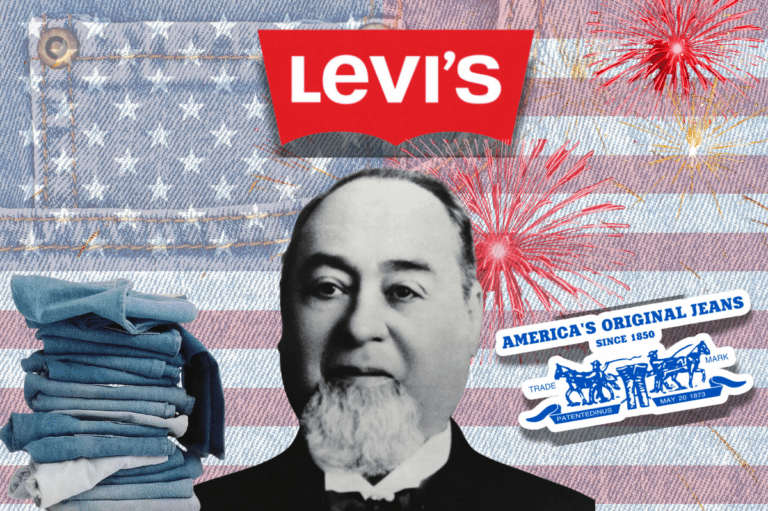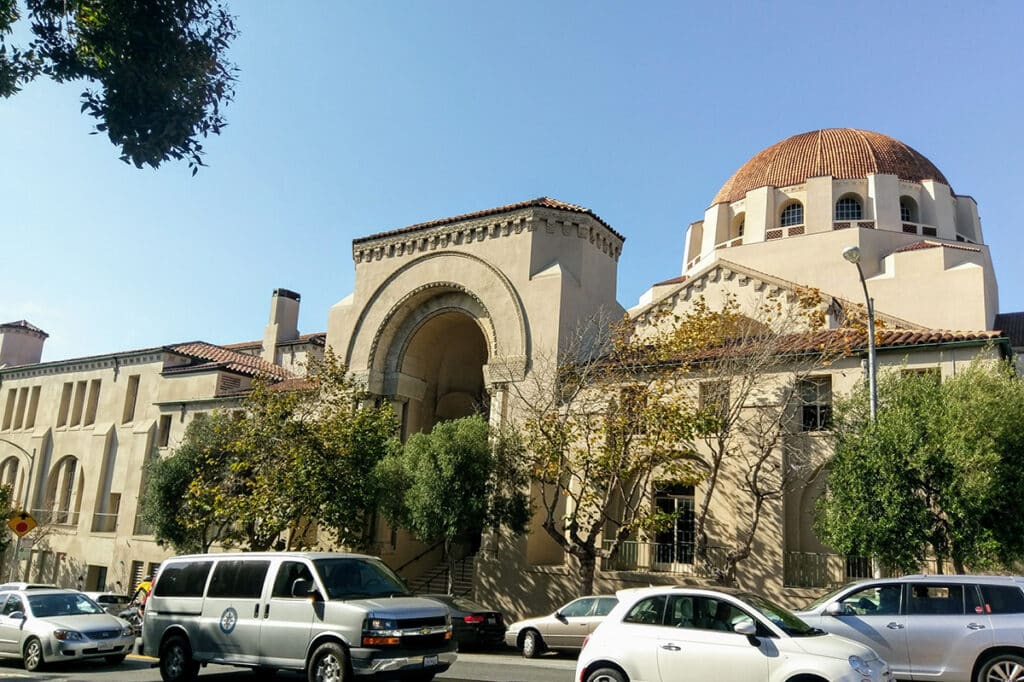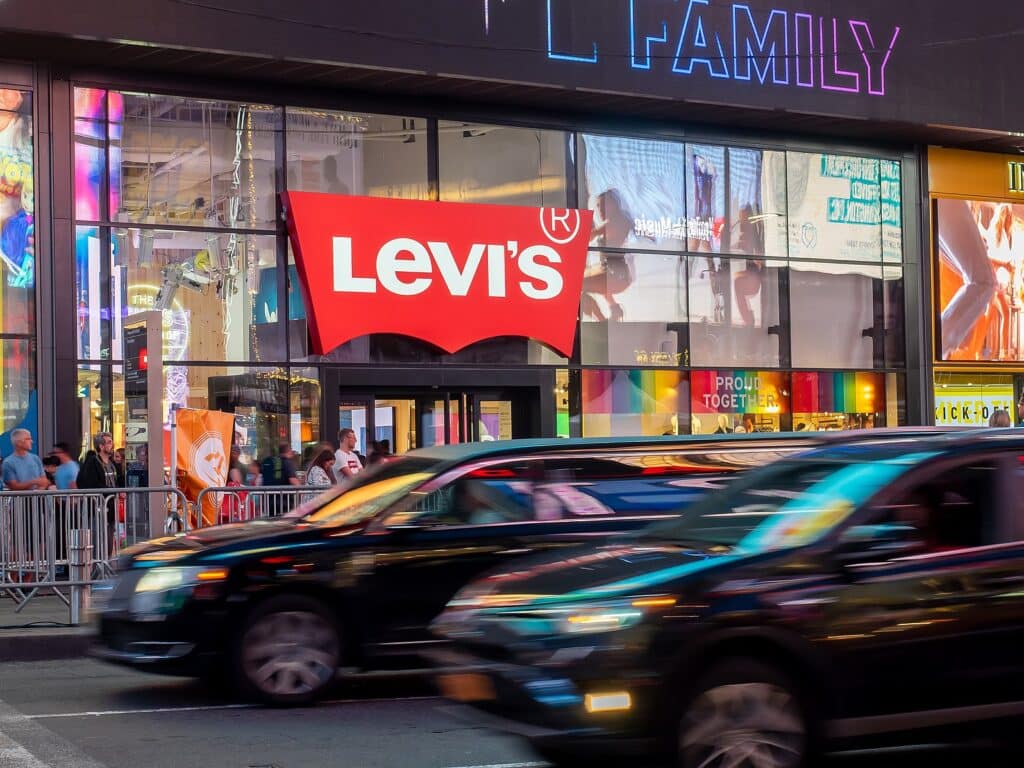
What American product is more popular than the denim blue jean? Each year, around 450 million pairs of jeans are sold across the U.S. and a whopping 1.25 billion pairs are bought worldwide. A 2023 PBS documentary, “Riveted: The History of Jeans,” tells us “half the population of the planet are wearing them on any given day.”
But did you know that the incredible story of blue jeans starts in the Kingdom of Bavaria (now Germany) and a Jewish merchant’s 1873 invention?
Let’s unpack the fascinating story of Jewish entrepreneur Levi Strauss and his pursuit of the American dream.
Who was Levi Strauss?
Levi Strauss was born to Jewish parents in Buttenheim, Bavaria on Feb. 26, 1829. Since Jews were banned from owning land, they were excluded from common occupations like livestock herding and farming, so many without formal educations became peddlers.
Strauss’ father, Hirsch, was a dry goods peddler, selling textiles; sewing supplies; clothing; and grocery staples like tobacco, sugar, flour, and coffee. Hirsch sold his wares door-to-door from a pushcart. He and his second wife Rebecca raised a large, blended family, and young Levi grew up with six siblings in a three-room apartment.

The Strauss family worshiped at the synagogue in Buttenheim and Strauss attended Hebrew school. His father died of tuberculosis in 1846 when Levi was only 17 years old. The next year, Strauss, his mother and his sisters immigrated to New York City to join his two older brothers who had opened a dry goods company similar to their father’s business in Germany. They named the company “J. Strauss Brother & Co.” and the family lived on the Lower East Side in Manhattan, a neighborhood known as “Kleindeutschland” or “Little Germany.”
The history of San Francisco’s Jewish community
Then came a pivotal point in American history. The 1848 discovery of gold in California caused an influx of 250,000 people to travel to San Francisco, transforming the area from a sleepy Mexican village with a population of a few hundred into a burgeoning city.
Read more: The Jews of the Wild West
During the Gold Rush, a small Jewish community formed around San Francisco. In 1849, California saw its first minyan and High Holy Days service held under a tent with 30 Jewish traders and merchants from Eastern Europe and the East Coast. The next year, 16 Bavarian Jews founded San Francisco’s first Jewish synagogue — Congregation Emanu-El, which still exists to this day.

Unlike previous generations of Jews who flocked to established metropolises like New York and Philadelphia, the San Francisco transplants entered a city without public institutions or services. Jewish immigrants helped build those power structures from scratch and became important businessmen, elected officials, and community leaders — positions often barred to Jews and immigrants in other major cities.
Jewish immigrants to San Francisco became so entrenched in the community that an 1861 visitor remarked, “On a first arrival in our city, it becomes a matter of astonishment to all who see the large number of mercantile houses conducted by Israelites…Every line of business is engaged in by them, with credit to themselves and honor to the community.”
Spurred by German and Bavarian immigration, San Francisco’s Jewish population continued to grow long after the Gold Rush. By 1870, 10% of the San Francisco population was Jewish, the second largest Jewish population in the nation, exceeded only by New York City.
Levi Strauss‘ move to San Francisco
Strauss, who had recently turned 24, wanted to be a part of the Gold Rush financial boon. In San Francisco, he saw the opportunity to sell the family’s dry goods products, and hopped on a steamship via Panama in March 1853 to set up his first store with his brother-in-law, David Stern.
Upon his arrival, Strauss became a supporter of Congregation Emanu-El, and developed scores of business connections and customers among local residents.
By the early 1870’s, Levi had built a thriving business on Sacramento Street that sold bedding, sewing supplies, umbrellas, and fabrics to dozens of loyal customers, including a tailor named Jacob Davis, who would be instrumental in the creation of the classic Levi’s everyone knows.
The birth of the blue jean
Davis was a Jewish tailor from Latvia who had immigrated to Reno, Nevada. He bought a lot of denim from Strauss, which he made into pants for the miners around in the region.
Mining work was so strenuous that the pants Davis made easily wore out or ripped. He had the innovative idea that strengthening seams with metal rivets could solve the problem, but lacked the resources to manufacture the creation on a large enough scale.
On July 2, 1872, Davis wrote to Strauss and asked him to enter a manufacturing partnership, in addition to a request for Strauss to pay for a patent application fee.
Strauss saw a tremendous business opportunity and agreed to the proposal. The next year, the duo received a patent for their denim work pants with reinforcing rivets on the pockets, seams, and base of the button-down fly. In the manufacturing stage, Strauss and Davis decided to dye the naturally-white denim blue because a darker color would easily hide stains, and the blue dye from indigo plants was locally grown.
Levi’s was an instant success
Their denim riveted pants and overalls were an immediate sensation. Soon, Strauss and Davis owned a factory, dozens of sewing machines and 50 machine operators.
Customers loved their product and bought blue jeans for four times the going rate —$2 a pair as opposed to $0.50. Demand for their revolutionary design skyrocketed and a second factory opened in New York City under the leadership of Strauss’ brother Jonas.
By the mid 1870’s, Levi’s was selling tens of thousands of pairs each year and Strauss was named as one of San Francisco’s first millionaires in an 1874 New York Times article.
Today, Levi’s jeans are a $91 billion per year industry, a symbol of American culture, and the world’s most popular piece of clothing.

The legacy of Levi’s
The man from Buttenheim, Bavaria left an impressive legacy for the San Francisco business community far beyond pioneering the iconic American blue jean — as a charter member and treasurer of the San Francisco Board of Trade in 1877; a director of the Nevada Bank, the Liverpool, London and Globe Insurance Company and the San Francisco Gas and Electric Company.
Strauss was equally committed to tzedakah and is remembered as one of San Francisco’s most active and generous philanthropists. In 1897, he funded 28 scholarships at the University of California, Berkeley in a program that is still active today.
Within the Jewish community, Strauss annually donated a gold medal to the Hebrew school student with the best grades at Congregation Emanu-El. In addition to supporting his synagogue, he lent his support to helping Jewish widows, orphanages, and schools.
On Sept. 26, 1902, Strauss passed away at the age of 73. His will demonstrated his commitment to tzedakah one final time, leaving tens of thousands of dollars (the equivalent of about $1 million in 2024) to the Pacific Hebrew Orphan Asylum, the Home for Aged Israelites, the Eureka Benevolent Association, and San Francisco’s Roman Catholic and Protestant orphanages.


